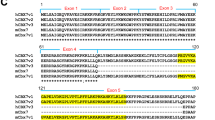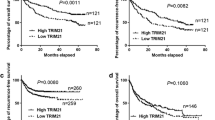Abstract
BH3-only protein Bim is a critical regulator of apoptosis and plays an essential role in mammalian development, but the characterization of Bim and its isoforms in hepatocellular carcinoma (HCC) has not been studied before. Here we investigated the expression, distribution, regulation and role of Bim isoforms in HCC cells. Fifteen Bim isoforms were identified in HCC, with six newly identified isoforms and two newly identified exons. Among of them, Bim EL, L, S, a1, a2, a3, b2, b4 and b6 are abundant isoforms according to their mRNA levels. However only Bim EL, L and S proteins could be clearly detected. Bim mRNA and protein were strongly expressed in HCC tissues compared to relevant non-tumorous regions, but the ratio of variant isoforms showed no difference between tumorous and non-tumorous tissues. Bim isoforms were differentially regulated after chemotherapeutic drug 5-Fluorouracil (5-FU) treatment. Interestingly, Bim EL, L and S, the isoforms known to induce apoptosis strongly, are the least inducible isoforms at their mRNA levels when exposed to the stress, suggesting that post-transcriptional rather than transcriptional, modulations may play a role to enhance their functions. Finally, overexpression of Bim EL, L, S and all alpha isoforms induced apoptosis in HCC cells, while overexpression of Bim beta isoforms showed no effects on cell survival after 5-FU treatment. In conclusion, Bim alpha isoforms appears to have a role in the regulation of apoptosis in HCC cells, which may contribute to not only the growth of tumor cells but also the sensitivity of HCC cells to chemotherapy.







Similar content being viewed by others
References
Yin XM (2000) Bid, a critical mediator for apoptosis induced by the activation of Fas/TNF-R1 death receptors in hepatocytes. J Mol Med 78:203–211
Takehara T, Liu XL, Fujimoto J, Friedman SL, Takahashi H (2001) Expression and role of Bcl-xL in human hepatocellular carcinomas. Hepatology 34:55–61
Cory S, Huang DCS, Adams JM (2003) The Bcl-2 family: roles in cell survival and oncogenesis. Oncogene 22:8590–8607
Wang XD (2001) The expanding role of mitochondria in apoptosis. Genes Dev 15:2922–2933
Willis SN, Adams JM (2005) Life in the balance: how BH3-only proteins induce apoptosis. Curr Opin Cell Biol 17:617–625
Hsu SY, Lin P, Hsueh AJW (1998) BOD (Bcl-2-related ovarian death gene) is an ovarian BH3 domain-containing proapoptotic Bcl-2 protein capable of dimerization with diverse antiapoptotic Bcl-2 members. Mol Endocrinol 12:1432–1440
Liu XQ, Dai SD, Zhu YN, Marrack P, Kappler JW (2003) The structure of a Bcl-xL/Bim fragment complex: implications for Bim function. Immunity 19:341–352
O’Connor L, Strasser A, O’Reilly LA, Hausmann G, Adams JM, Cory S, Huang DCS (1998) Bim: a novel member of the Bcl-2 family that promotes apoptosis. Embo J 17:384–395
Puthalakath H, Huang DCS, O’Reilly LA, King SM, Strasser A (1999) The proapoptotic activity of the Bcl-2 family member Bim is regulated by interaction with the dynein motor complex. Mol Cell 3:287–296
Strasser A, Puthalakath H, Bouillet P, Huang DCS, O’Connor L, O’Reilly L, Cullen L, Cory S, Adams JM (2000) The role of bim, a proapoptotic BH3-only member of the Bcl-2 family in cell-death control. Ann N Y Acad Sci 917:541–548
O’Reilly LA, Cullen L, Visvader J, Lindeman GJ, Print C, Bath ML, Huang DCS, Strasser A (2000) The proapoptotic BH3-only protein bim is expressed in hematopoietic, epithelial, neuronal, and germ cells. Am J Pathol 157:449–461
Gilley J, Coffer PJ, Ham J (2003) FOXO transcription factors directly activate bim gene expression and promote apoptosis in sympathetic neurons. J Cell Biol 162:613–622
Putcha GV, Moulder KL, Golden JP, Bouillet P, Adams JA, Strasser A, Johnson EM (2001) Induction of BIM, a proapoptotic BH3-only BCL-2 family member, is critical for neuronal apoptosis. Neuron 29:615–628
Whitfield J, Neame SJ, Paquet L, Bernard O, Ham J (2001) Dominant-negative c-Jun promotes neuronal survival by reducing BIM expression and inhibiting mitochondrial cytochrome c release. Neuron 29:629–643
Bouillet P, Metcalf D, Huang DCS, Tarlinton DM, Kay TWH, Kontgen F, Adams JM, Strasser A (1999) Proapoptotic Bcl-2 relative Bim required for certain apoptotic responses, leukocyte homeostasis, and to preclude autoimmunity. Science 286:1735–1738
Chen JZ, Ji CN, Gu SH, Li JX, Zhao EP, Huang Y, Huang L, Ying K, Xie Y, Mao YM (2004) Over-expression of Bim alpha3, a novel isoform of human Bim, result in cell apoptosis. Int J Biochem Cell Biol 36:1554–1561
Liu JW, Chandra D, Tang SH, Chopra D, Tang DG (2002) Identification and characterization of Bimgamma, a novel proapoptotic BH3-only splice variant of Bim. Cancer Res 62:2976–2981
Marani M, Tenev T, Hancock D, Downward J, Lemoine NR (2002) Identification of novel isoforms of the BH3 domain protein Bim which directly activate Bax to trigger apoptosis. Mol Cell Biol 22:3577–3589
U M, Miyashita T, Shikama Y, Tadokoro K, Yamada M (2001) Molecular cloning and characterization of six novel isoforms of human Bim, a member of the proapoptotic Bcl-2 family. FEBS Lett 509:135–141
Chen GG, Lai PBS, Chan PKS, Chak ECW, Yip JHY, Ho RLK, Leung BCS, Lau WY (2001) Decreased expression of Bid in human hepatocellular carcinoma is related to hepatitis B virus X protein. Eur J Cancer 37:1695–1702
Miao J, Chen GG, Chun SY, Chak ECW, Lai PBS (2004) Bid sensitizes apoptosis induced by chemotherapeutic drugs in hepatocellular carcinoma. Int J Oncol 25:65165–65169
Miao J, Chen GG, Chun SY, Yun JP, Chak ECW, Ho RLK, Lai PBS (2006) Adenovirus-mediated tBid overexpression results in therapeutic effects on p53-resistant hepatocellular carcinoma. Int J Cancer 119:1985–1993
Chen GG, Lai PBS, Chak ECW, Xu H, Lee KM, Lau WY (2001) Immunohistochemical analysis of pro-apoptotic Bid level in chronic hepatitis, hepatocellular carcinoma and liver metastases. Cancer Lett 172:75–82
Adachi M, Zhao X, Imai K (2005) Nomenclature of dynein light chain-linked BH3-only protein Bim isoforms. Cell Death Differ 12:192–193
Lei K, Davis RJ (2003) JNK phosphorylation of Bim-related members of the Bcl2 family induces Bax-dependent apoptosis. Proc Natl Acad Sci USA 100:2432–2437
Bouillet P, Huang DCS, O’Reilly LA, Puthalakath H, O’Connor L, Cory S, Adams JM, Strasser A (2000) The role of the pro-apoptotic Bcl-2 family member bim in physiological cell death. Ann N Y Acad Sci 926:83–89
Tan TT, Degenhardt K, Nelson DA, Beaudoin B, Nieves-Neira W, Bouillet P, Villunger A, Adams JM, White E (2005) Key roles of BIM-driven apoptosis in epithelial tumors and rational chemotherapy. Cancer Cell 7:227–238
Putcha GV, Le SY, Frank S, Besirli CG, Clark K, Chu BY, Alix S, Youle RJ, LaMarche A, Maroney AC, Johnson EM (2003) JNK-mediated BIM phosphorylation potentiates BAX-dependent apoptosis. Neuron 38:899–914
Watanabe J, Kushihata F, Honda K, Sugita A, Tateishi N, Mominoki K, Matsuda S, Kobayashi N (2004) Prognostic significance of Bcl-xL in human hepatocellular carcinoma. Surgery 135:604–612
Chiu CT, Yeh TS, Hsu JC, Chen MF (2003) Expression of Bcl-2 family modulated through p53-dependent pathway in human hepatocellular carcinoma. Digestive Diseases Sci 48:670–676
Acknowledgements
We thank Genome Research Centre of the University of Hong Kong and, Department of Biochemistry, The Chinese University of Hong Kong for providing DAN facilities for this study.
Author information
Authors and Affiliations
Corresponding author
Rights and permissions
About this article
Cite this article
Miao, J., Chen, G.G., Yun, JP. et al. Identification and characterization of BH3 domain protein Bim and its isoforms in human hepatocellular carcinomas. Apoptosis 12, 1691–1701 (2007). https://doi.org/10.1007/s10495-007-0093-5
Published:
Issue Date:
DOI: https://doi.org/10.1007/s10495-007-0093-5




